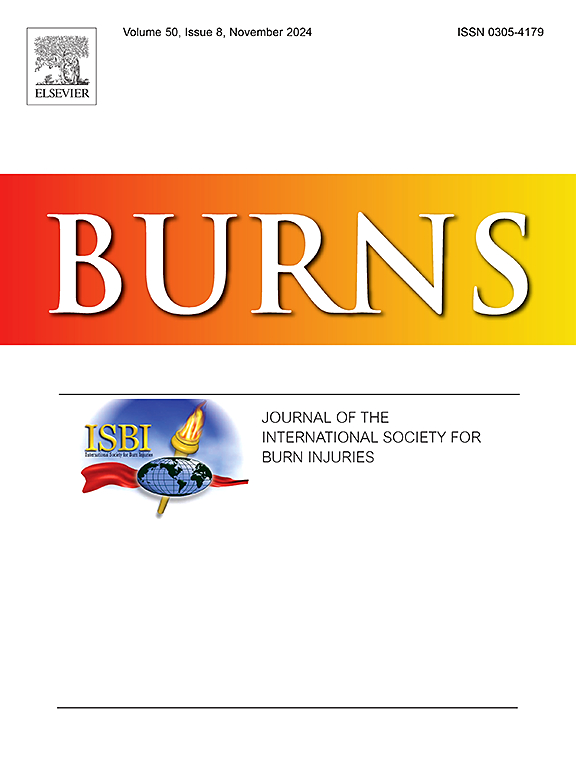Baicalin promotes the survival of flaps by downregulating the JAK2-STAT3 signaling pathway
IF 2.9
3区 医学
Q2 CRITICAL CARE MEDICINE
引用次数: 0
Abstract
Background
Skin flaps are commonly employed in wound reconstruction and plastic surgery, yet frequently develop distal necrosis post-transplantation. Baicalin, a principal bioactive compound derived from the traditional Chinese medicinal herb Scutellaria baicalensis Georgi, has not been systematically investigated for its potential to enhance flap viability.
Materials and methods
Firstly, this study used bioinformatics analysis to identify potential regulatory targets and signaling pathways involved in flap ischemia-reperfusion (I/R) injury. Secondly, a McFarlane random flap model (3 × 9 cm) was established on the back of rats to evaluate the effects of different doses of baicalin (60 mg/kg and 120 mg/kg, oral gavage) and JAK2-STAT3 inhibitor AG490 (1 mg/kg, intraperitoneal injection) on the random flap necrosis rate. Finally, on the 7th day after surgery, skin flap tissue was collected to evaluate the effects of baicalin on blood perfusion, neovascularization, histopathological changes, oxidative stress markers (SOD and MDA), JAK2-STAT3 signaling pathway, and apoptosis related protein (Bcl-2 and BAX) expression levels.
Results
Bioinformatics analysis shows that during the stages of tissue ischemia and reperfusion, signaling pathways such as VEGF, cytokines, JAK2-STAT3, and apoptosis play important regulatory roles. In the rat random flap model, research has found that baicalin reduces the rate of flap necrosis in a dose-dependent manner. The mechanism of action includes increasing blood flow perfusion and angiogenesis, reducing I/R injury, and inhibiting the inflammatory response by inhibiting the JAK2-STAT3 signaling pathway.
Conclusions
This study confirms that baicalin can promote the survival of random flaps and reveals the mechanism.
黄芩苷通过下调JAK2-STAT3信号通路促进皮瓣存活
背景皮瓣常用于伤口重建和整形手术,但移植后经常发生远端坏死。黄芩苷是一种从黄芩中提取的主要生物活性化合物,其增强皮瓣活力的潜力尚未得到系统的研究。材料与方法本研究首先通过生物信息学分析,确定皮瓣缺血再灌注(I/R)损伤的潜在调控靶点和信号通路。其次,在大鼠背部建立McFarlane随机皮瓣模型(3 × 9 cm),评价不同剂量黄芩苷(60 mg/kg和120 mg/kg,灌胃)和JAK2-STAT3抑制剂AG490(1 mg/kg,腹腔注射)对随机皮瓣坏死率的影响。最后,于术后第7天采集皮瓣组织,观察黄芩苷对大鼠血液灌注、新生血管形成、组织病理改变、氧化应激标志物(SOD、MDA)、JAK2-STAT3信号通路、凋亡相关蛋白(Bcl-2、BAX)表达水平的影响。结果生物信息学分析表明,在组织缺血再灌注阶段,VEGF、细胞因子、JAK2-STAT3、细胞凋亡等信号通路发挥重要调控作用。在大鼠随机皮瓣模型中,研究发现黄芩苷降低皮瓣坏死率呈剂量依赖性。其作用机制包括增加血流灌注和血管生成,减少I/R损伤,以及通过抑制JAK2-STAT3信号通路抑制炎症反应。结论黄芩苷具有促进随机皮瓣成活的作用,并揭示了其作用机制。
本文章由计算机程序翻译,如有差异,请以英文原文为准。
求助全文
约1分钟内获得全文
求助全文
来源期刊

Burns
医学-皮肤病学
CiteScore
4.50
自引率
18.50%
发文量
304
审稿时长
72 days
期刊介绍:
Burns aims to foster the exchange of information among all engaged in preventing and treating the effects of burns. The journal focuses on clinical, scientific and social aspects of these injuries and covers the prevention of the injury, the epidemiology of such injuries and all aspects of treatment including development of new techniques and technologies and verification of existing ones. Regular features include clinical and scientific papers, state of the art reviews and descriptions of burn-care in practice.
Topics covered by Burns include: the effects of smoke on man and animals, their tissues and cells; the responses to and treatment of patients and animals with chemical injuries to the skin; the biological and clinical effects of cold injuries; surgical techniques which are, or may be relevant to the treatment of burned patients during the acute or reconstructive phase following injury; well controlled laboratory studies of the effectiveness of anti-microbial agents on infection and new materials on scarring and healing; inflammatory responses to injury, effectiveness of related agents and other compounds used to modify the physiological and cellular responses to the injury; experimental studies of burns and the outcome of burn wound healing; regenerative medicine concerning the skin.
 求助内容:
求助内容: 应助结果提醒方式:
应助结果提醒方式:


